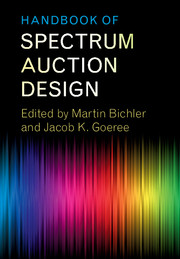Book contents
- Frontmatter
- Contents
- List of Contributors
- Preface
- List of Papers
- Part I The Simultaneous Multiple-Round Auction
- Part II The Combinatorial Clock Auction Designs
- 5 Combinatorial Auction Design
- 6 The Clock-Proxy Auction: A Practical Combinatorial Auction Design
- 7 Spectrum Auction Design
- 8 A Practical Guide to the Combinatorial Clock Auction
- 9 Market Design and the Evolution of the Combinatorial Clock Auction
- 10 Quadratic Core-Selecting Payment Rules for Combinatorial Auctions
- 11 Core-Selecting Package Auctions
- 12 A New Payment Rule for Core-Selecting Package Auctions
- 13 On the Impossibility of Core-Selecting Auctions
- 14 Ascending Combinatorial Auctions with Risk Averse Bidders
- 15 Properties of the Combinatorial Clock Auction
- 16 Budget Constraints in Combinatorial Clock Auctions
- 17 (Un)expected Bidder Behavior in Spectrum Auctions: About Inconsistent Bidding and its Impact on Efficiency in the Combinatorial Clock Auction
- Part III Alternative Auction Designs
- Part IV Experimental Comparisons of Auction Designs
- Part V The Bidders’ Perspective
- Part VI Secondary Markets and Exchanges
- Outlook
- References
8 - A Practical Guide to the Combinatorial Clock Auction
from Part II - The Combinatorial Clock Auction Designs
Published online by Cambridge University Press: 26 October 2017
- Frontmatter
- Contents
- List of Contributors
- Preface
- List of Papers
- Part I The Simultaneous Multiple-Round Auction
- Part II The Combinatorial Clock Auction Designs
- 5 Combinatorial Auction Design
- 6 The Clock-Proxy Auction: A Practical Combinatorial Auction Design
- 7 Spectrum Auction Design
- 8 A Practical Guide to the Combinatorial Clock Auction
- 9 Market Design and the Evolution of the Combinatorial Clock Auction
- 10 Quadratic Core-Selecting Payment Rules for Combinatorial Auctions
- 11 Core-Selecting Package Auctions
- 12 A New Payment Rule for Core-Selecting Package Auctions
- 13 On the Impossibility of Core-Selecting Auctions
- 14 Ascending Combinatorial Auctions with Risk Averse Bidders
- 15 Properties of the Combinatorial Clock Auction
- 16 Budget Constraints in Combinatorial Clock Auctions
- 17 (Un)expected Bidder Behavior in Spectrum Auctions: About Inconsistent Bidding and its Impact on Efficiency in the Combinatorial Clock Auction
- Part III Alternative Auction Designs
- Part IV Experimental Comparisons of Auction Designs
- Part V The Bidders’ Perspective
- Part VI Secondary Markets and Exchanges
- Outlook
- References
Summary
Since its proposal in a 2006 academic paper, the combinatorial clock auction (CCA) has rapidly established itself as one of the leading formats for government auctions of telecommunications spectrum. Its initial implementations were for relatively small auctions and some of these applications may be viewed as experimental. However, in the past few years, usage of the CCA has gained substantial momentum. From 2012 to this writing in 2015, the CCA has been used for more than ten major spectrum auctions worldwide, allocating prime sub-1-GHz spectrum on three continents and raising approximately $20 billion in revenues (see Table 1). Despite the presence of an existing auction format—the simultaneous multiple round auction (SMRA)—which often performs reasonably well, the CCA has the potential of displacing it and becoming the new standard design choice for spectrum auctions.
The CCA design consists of a two-stage bidding process. The first stage, known as the clock rounds, is a multiple-round clock auction. In each round, the auctioneer announces prices for all items and bidders respond with quantities demanded at these prices. If aggregate demand exceeds available supply for any items, the auctioneer announces higher prices for these items in the next round. The bidding process continues until prices reach a level at which aggregate demand is less than or equal to supply for every item. The second stage, known as the supplementary round, is a sealed-bid auction process in which bidders can improve their bids made in the first stage and submit additional bids as desired for other combinations of items. Throughout the entire auction, all bids are treated as all-or-nothing package bids.
To determine winnings and associated payments, all bids placed during the clock rounds and all bids placed in the supplementary round are entered together into a standard winner determination problem (WDP). Winning packages are determined by finding an allocation that maximizes the total value (as reflected in bids) subject to feasibility constraints: each item can be sold only once and only one bid from each bidder can be selected as part of the winning allocation.
Information
- Type
- Chapter
- Information
- Handbook of Spectrum Auction Design , pp. 170 - 186Publisher: Cambridge University PressPrint publication year: 2017
